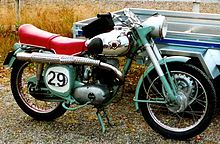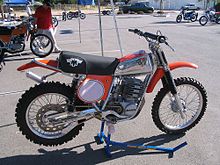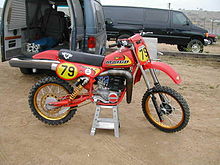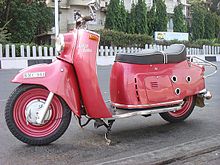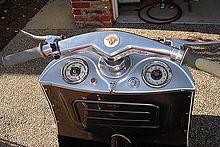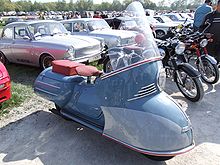- Maico
-
For the manga series, see Maico 2010.
Maicowerk A.G. was founded in 1926, originally assembling 98 and 123 cc Ilo two stroke motors. After World War II the West German motorcycle manufacturer began producing its own unit construction two stroke engines, selling engines and complete motorcycles. Maico (pronounced MY-co, similar to "Kaiser") made a brief foray into the automobile business with their own line of microcars in the late 1950s. Maico have also made Go kart engines.[1]
The road motorcycles were named after winds... 'Blizzard' 'Typhoon' etc., but the company was better known for its purpose-built Motocross and Enduro machines, and for its 'Maicoletta' motor scooter, both of which sold in higher numbers than the road motorcycles.
Contents
Maico racing motorcycles
Maico motocross (MC) and enduro (GS) racing models proved very successful in both European and American competition throughout the 1970s. While lacking the financial capital and big money race-team backing like that of the Japanese factories of Honda, Yamaha, Suzuki, and Kawasaki, Maico riders such as Adolf Weil, Åke Jonsson and Willy Bauer proved to be a serious challenge to the Japanese factories and produced numerous top three finishes in both World and US Championship motocross competitions. U.S. publication Motocross Action called the 1981 Maico Mega 490 the greatest open-class motocross bike of all time. The 1974.5 400cc and 440cc GP, and 1981 490cc models along with any year 501cc motocross bike are some of the most sought-after vintage MX and twin-shock motorcycles to this day.
Maicowerk AG filed for bankruptcy in 1983 but continued to produce small numbers of motocross and enduro models (re-badged as M-Stars in the United States due to legal issues) up through 1986. Subsequent manufacturers have purchased the brand name and applied it to their own limited production motorcycles. Modern open-class dirt-bikes are still being produced under the Maico brandname[2] The ATK Intimidator dirt-bike (reportedly the most powerful production 2 stroke motorcycle available aside from Maico's own bikes) features a Maico motor.[3]
One of the largest contributions to the world of motocross suspension technology came in the 1974 season when the Wheelsmith Motorcycles team in the USA and the Gunther Schier teams in Europe forward-mounted the rear shocks on the Maico works bikes, immediately increasing the travel and ability to trump the competition. This initiated a frantic effort on the part of factory teams and privateers alike; chopping up their frames in a desperate attempt to remain competitive.
The Maicowerk AG company went out of business in the 1980s and its assets were taken over by a Dutch company.
Maicoletta
Main article: MaicolettaThe Maicoletta motor scooter of the 1950s was one of the largest motor scooters produced by any manufacturer until the modern era. The engine was a single cylinder 247cc piston port 2-stroke (an export version featuring a 277cc engine was also produced for use with a sidecar), with four foot-operated gears, enclosed chain drive, centrifugal fan cooling and electric start. This was fitted to a tubular frame built on motorcycle principles with long travel telescopic forks and 14-inch wheels. The Maicoletta had a top speed of greater than 70 mph, comparable with most 250cc motorcycles of the time. In the 1950s most scooters such as Vespa, Lambretta, were 125cc to 200cc with 8-10 inch wheels and a top speed of 55 to 60 mph, so the expensive but fast and comfortable Maicoletta developed a following amongst scooter club enthusiasts.
By modern standards the brakes (drum front and rear) leave something to be desired, but compared to those of other scooters from the period, the brakes are not inferior.
Pendulum starter An unusual Bosch 6v 'pendulum' electric starter system was fitted, which was quite advanced for the 1950s, and about which there are a number of common misconceptions. When activated, instead of rotating the crankshaft the starter used the generator coils on the shaft to rock it back and forth under the control of cams on the crankshaft. These cams closed contacts in the generator to trigger a reversing switch in the Control box that changed the crankshaft direction at the end of each swing. This gives the impression of the crankshaft continually bouncing back and forwards against compression, when operated. A separate set of ignition points fired the spark plug in the forward direction only, and when this fires the mixture in the cylinder the engine starts to rotate normally, the starter is released and the normal ignition system takes over. The advantage of this system is that the starter does not have to force the crankshaft to turn over against compression, so less power is required from the 6volt system. Its disadvantage is the unusual number of contacts, which can be difficult to adjust. The reversing switch contacts tend to wear out with extended use and can be very difficult to get repaired, hence the scooter's reputation for requiring roll starts later in life.
Maico Mobil
The Maico Mobil, said to resemble a 'two wheeled car' was a highly enclosed two-wheel motorcycle which sold only in small numbers.
Notes
- ^ Title: The Illustrated Encyclopedia of Motorcycles, Editor: Erwin Tragatsch, Publisher: New Burlington Books, Copyright: 1979 Quarto Publishing, Edition: 1988 Revised, Page 198, ISBN 0-906286-07-7
- ^ Maico UK Home.
- ^ Starring The 700cc Intimidator - Wild New Machines From ATK! - Dirtbike at Off-Road.com
References
Major and Notable German motorcycle marques Categories:- Companies established in 1926
- Motorcycle engines
- Motorcycle manufacturers of Germany
- Two-stroke petrol engines
Wikimedia Foundation. 2010.

